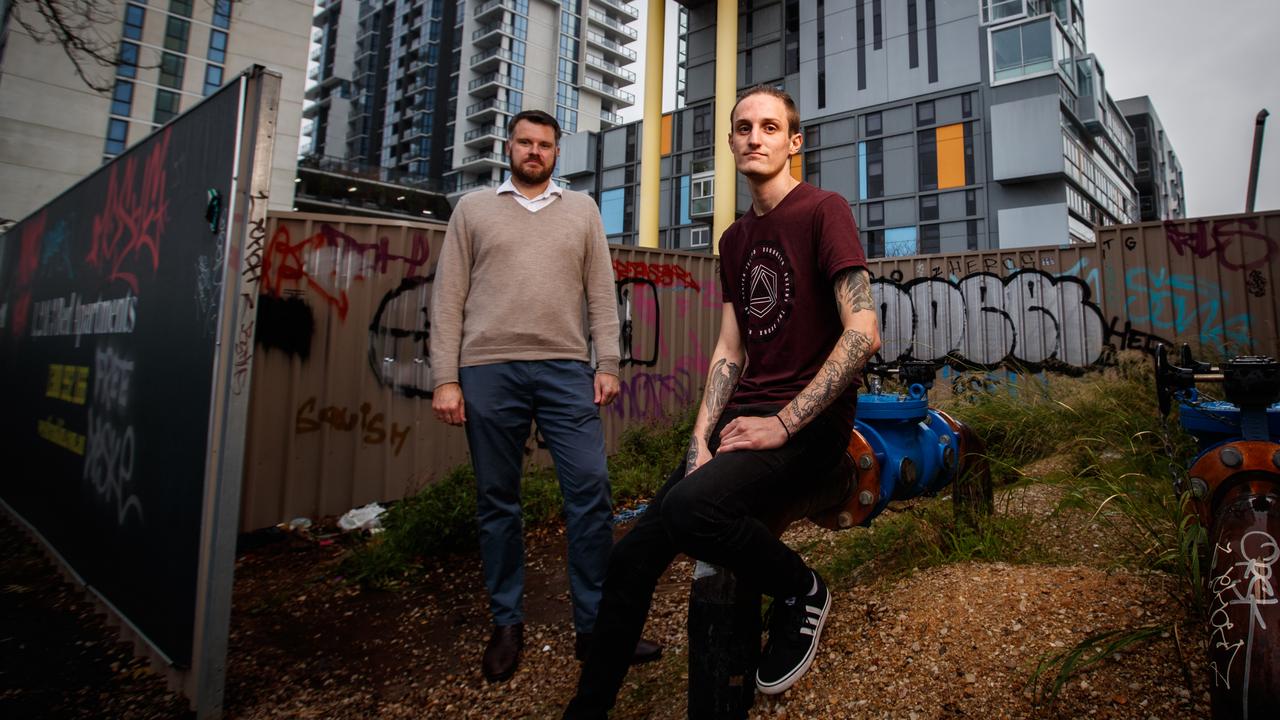Deaf Metal: How a lifetime of rock’n’roll impacts the hearing of our musicians
It’s a sensation that any South Australian who has been to a rock concert knows — that itchy discomfort in your ears as they strain to take in the cacophony of sounds. But for rockers who have spent their life in music, it’s a much bigger issue.
SA Weekend
Don't miss out on the headlines from SA Weekend. Followed categories will be added to My News.
- Cochlear implant pioneer Dr John Rice gets own hearing implant
- OPINION: I’m deaf, but nobody wants to hear about it
I’m watching Portland, Oregon sludge metal hooligans Red Fang rip through a set of riff-heavy rock in the cavernous surrounds of Fowlers Live and my ears are … well, they’re itching.
The band is so loud that it’s causing a physical sensation that forces me to poke my fingers deep into my earholes every 20 or so seconds to give them a good scratch.
It doesn’t exactly hurt, but it doesn’t feel that good either.
Then, somewhere around the third or fourth song, the itching sensation stops and it’s like my ears finally adjust to the sonic assault and I’m able to enjoy the rest of the show.
Looking around the crowd of mainly black-clad blokes there’s hardly an earplug to be seen. Lying in bed after the show and sounds like a colony of cicadas has taken up residence inside my skull.
If my ears are hurting after just one show, what about the men and women on stage pumping out the noise night after night?
What about the roadies, the sound engineers and even the bartenders?
Are they all slowly going deaf (answer: yes) and is this actually a workplace safety issue (answer: maybe).
John Brewster, one half of the legendary Brewster Brothers — the twin-pronged guitar attack that’s the engine room of The Angels — is enjoying a flat white in an Adelaide cafe.
You have to look very closely to see the barely-detectable wires running from behind his head and into his ears.
More than 40 years of cranking out high-decibel rock ’n’ roll has taken its toll on Brewster’s hearing, and he’s finally bitten the bullet and invested in a hearing aid.
“It’s actually from Costco,” the 70-year-old laughs, “But it’s top-of-the-range.”
Brewster pulls out his iPhone and demonstrates how, using an app that connects to the hearing aid via Bluetooth, he can control what he hears.
Press one button and the hearing aid focuses on my questions coming from across the table, blocking out peripheral sounds like the clanking of dishes from behind the counter.
Press another, and it goes into surround-sound mode, pulling in noises from 360 degrees.
He can even have phone calls transmitted straight into his ears.
Brewster admits that he should have taken better care of his ears, but says he’s far from the only ageing rocker struggling with hearing loss.
“Have a look. Hearing aids. I’ve had these for about four weeks, but I should have had them for the last six years,” he says.
“In the early days we wore no ear protection at all, and in the later days I did but I couldn’t stand how they muffled the sound so I’d wear one in one ear and leave the other one open. I’d use one to block out the drums a little because the cymbals are really hard on your hearing.”
Like many people who find their hearing slipping as they age, Brewster was in denial at first.
“I’d be kidding myself that my hearing was all right, but we’d go to dinner and I’d say to my wife Sue — you always treat the people you love most the worst — ‘I JUST CAN’T HEAR!’,” he says.
“I’d ask her to spell words, and that’s when she’d get up and walk out of the room.
“Now we can go to dinner and I hear every word. You either live with it — and frustrate the hell out of everyone — or you get it fixed.”

Brewster says that if 100 per cent of rockers didn’t suffer from hearing loss then “it would have to be pretty close”.
At the end of the day he blames the percussion. Like everything else in rock music, it’s usually the drummer’s fault.
“I suppose you could ask yourself, ‘why did we play so loud for all those years’, but the truth is you play to the level of the drums. You have to be louder than the drums, and the drums are loud.
“And the other thing is you can’t be in a successful rock band unless you’re digging it! It was exciting, and it still is for me all these years later. You get a high from it.”
Brewster’s advice to young musos is to invest in a pair of good quality noise-reducing ear plugs.
“They take all the frequencies down the same amount so you can still hear everything. It’s 40 years too late for me though.”
It’s also too late for AC/DC frontman Brian Johnson, Pete Townshend of The Who, Ozzy Osbourne, Eric Clapton, Coldplay’s Chris Martin, Liam Gallagher, Daft Punk’s Thomas Bangalter, Phil Collins and Neil Young, just to name a few high-profile hearing casualties.
Johnson’s hearing loss (which he partly blames on his second love, motor racing) forced him to quit as the singer of perhaps the most popular band in hard rock history.
Young developed a condition called hyperacusis — acute sensitivity to loud noise — after touring his 1990 rock masterpiece Ragged Glory.
His hearing was so shot that he actually retreated to his ranch and recorded the extremely mellow Harvest Moon. “I made Harvest Moon because I didn’t want to hear any loud sounds,” Young said in a 1995 interview.
Osbourne, who spent decades in front of the sonic force that was Black Sabbath, says his tinnitus sounds “like a ‘whee!’ noise in my head all the time”.
For Metallica drummer Lars Urlich, the important message is that hearing damage is often permanent.
“If you get a scratch on your nose, in a week that’ll be gone,” Urlich said in an interview. “When you scratch your hearing or damage your hearing, it doesn’t come back. I try to point out to younger kids. … once your hearing is gone, it’s gone, and there’s no real remedy.”


Experts agree that hearing damage can occur after exposure to noise above 85 decibels.
Stand in the front row of a rock concert and the noise level can easily exceed 120 decibels, well past the level that can induce permanent hearing loss. Stand in front of band for 10 years — or 20 or 30 — and it’s only fate that will prevent deafness.
The acceptable level of noise in a workplace over an eight-hour shift is 85 decibels — about the level you would get standing on the edge of South Rd during peak hour.
University of Melbourne research audiologist Siobhan McGinnity is also a musician — she performs under the moniker Magnets — so she’s in the unique position of fighting music-induced hearing loss and being at risk of suffering from it herself.
McGinnity says the widely-quoted figure among audiologists — taken from an article published in 2003 — is that 74 per cent of performing musicians have at least one form of hearing injury.
“That covers tinnitus, hearing loss, diplacusis (double hearing), distortion … there’s a range of problems,” she says.
McGinnity, who is currently working on a PhD thesis on hearing damage among musicians, says there’s no reason to accept hearing damage as an inevitable side effect of playing rock ’n’ roll for a living.
“I’m fascinated by the culture of live, loud music and how over time we’ve been conditioned to associate loud music with good music,” she says.
“There’s been a cultural pairing of those two things together, and that’s difficult to tease apart.”
McGinnity says the introduction of amplified instruments in the 1950s and ’60s meant that musos’ hearing was put at greater risk, but points out that even classical musicians can suffer the same ailments.
“This can depend on where you sit in the orchestra, and you’re more at risk in an orchestral pit environment where the sound is enclosed,” she says.
“There’s was a landmark case recently from the Royal Opera House where a musician who sat in front of the brass section sued for acoustic shock, and won.”
(Viola player Christopher Goldscheider sued the Royal Opera House after claiming his hearing was permanently damaged by the horns in Wagner’s Ring Cycle).

McGinnity says that hearing damage can take a lifetime to manifest, and that we should be taking lessons from the current crop of older musicians who are now facing hearing loss and deafness as they enter old age.
She says that music-induced hearing damage can often be felt as soon as it happens, but that it can also develop long after the exposure.
“We call the damage mechanical and metabolical,” she says.
“You can think of it as the physical effects that you feel on the night, and then the latent effects that come from chemical reactions within the body that can cause issues that can last much longer.
“So directly after a show you might have symptoms that heal over a day, but the latent effects might still be happening up to six months after the exposure.”
So what can we, as players or consumers of loud music, do to protect our hearing? Well we can stick something in our ears for a start.
“For musicians,” McGinnity says, “buying earplugs in whatever range you can afford is something you should do (the best plugs can run into the hundreds of dollars).
“Choice and Hearsmart recently released reviews of all the earplugs in that $30 range, and people should have a look at that. For punters, you also want to use earplugs because you want to be able to enjoy music for life. But, more importantly, listen to your body.
“Your ears give you signals when they need a rest. Are you hearing ringing after a night out? Do you feel your hearing is dull? Are you feeling like your ears are tired? Are you yelling to talk to people? These are all signs that you need to do something differently.”
For people who have dedicated their life to music, hearing damage can be devastating, stripping away their greatest love and their ability to earn a living at the same time.
“I had a musician crying in my office this morning because they had diplacusis — which 4 per cent of musicians have,” McGinnity says.
“Basically a single pitch gets split into two, and it’s the reason why many people are born tone deaf. But if you acquire it as a musician … I mean, imagine not being able to tell what key you’re in. It’s absolutely terrifying, and there’s no cure for it. But we have to stop seeing music-induced hearing loss as the only option, because it isn’t.”



